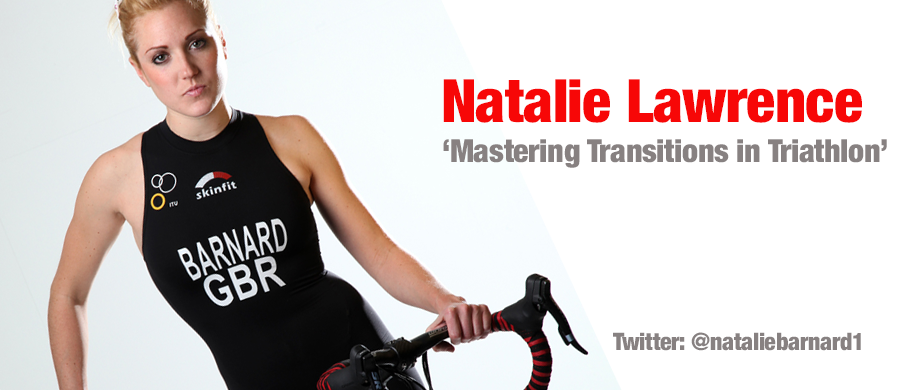Mastering Transitions in Triathlon
Following on from her first blog about being new to triathlon, Natalie gives some tips on this key section of the race for those both new and experienced in the triathlon.
At Elite level, the transitions can be the maker or breaker of your entire race believe it or not! You only need to watch the Olympics to see examples such as Helen Jenkins who came out of the swim with the top Brit girls, but failed in her transition which caused her to be the chase pack.
Luckily for all others, which are non-drafting races (meaning you ride solo for the cycling section, obeying the rules for distances apart from each rider on the course), the transition will not make or break your race, but can add to your overall time significantly!
So, what do I need for my transition area?
Here are a few key items you need or can build to having in your transition area:
- Bike: very fundamental item! The bike will be pre-racked before your race begins, either in a designated section, or anywhere you choose (race rule dependant). The bike is commonly racked by the saddle nose with the front wheel facing outwards as shown:

- Helmet: You MUST have your helmet here too, although you will not be allowed to race let alone gain access into transition if you do not possess a helmet. It can be place upside down on the handle bars or TT bars as above. (Upside down allows it to be placed onto your head faster to then clip).
- Run Shoes: for those new to triathlon that are a little unsure about the concept of cleats and clip on pedals, then you will do the bike section using your run trainers (which also allow a faster transition to the run course)! These are placed next to the bike as close as you can so that you are not interfering with others’ areas.
- Bike shoes: Again, bike shoes (with cleats and specific pedals), will allow for better riding conditions as you don’t lose any power through the pedals when performing each stroke. Some people opt to have the bike shoes next to the bike and will run in them towards the exit line before mounting.
However, if and when you feel a little more confident, there is the option to clip the shoes into the pedals ready to mount the bike at the line and slip your feet into them whilst gaining speed up.
TIP: to ensure your shoes do not ‘knock’ about when attached to the pedals, use elastic bands to loop through the backs of the shoes and then attach to the rear quick release and the front derailleur
As shown:

- Boxes: It is a new ruling that NO transition boxes are allowed next to your bike racking area- as it will impact others around you.
- Another little tip for those wanting a faster transition: if you choose to not put socks on for the bike and run shoes (more practical for super sprint, sprint and Olympic distances), then pop some talc powder in each bike shoe, this will help dry up the feet ready for the run.
- Number Belt: You CAN wear your number belt in the swim. Just have it clipped around your waist and tuck it into the wetsuit, then come the bike leg, turn the number to the back for visibility and then back to the front for the run. Alternatively, lay the belt across the handle bars of the bike pre-clipped and slip it on at T1

- Carrying Nutrition: On the bike it can be a tad tricky to do. Suggest if you have a tri suit that is a long distance (i.e. has pockets), then place your gels in them. Another tip is to lightly tape them on the top tube of the bike or use elastic bands. Have 1-2 bottles on the bike too depending on the duration of the bike. If you do not wish to use gels or carry them, try either squeezing 1x gel into a 500ml water bottle or use an electrolyte sports energy drink.
Mount and Dismount out of T1/ into T2:
- It is important to get the mount and dismount correct in your race, this can cause a DQ (disqualification) otherwise, which I personally have endured and it is as simple as a few inches.
- When coming OUT of T1 onto the bike, you must mount your bike AFTER the dismount line. There will always be a marshal and signs there to warn you. Here you can either jump on the bike with the shoes pre-attached and head off, or you run with the shoes on and then stop and mount after the line.
- When coming IN to T2 after your bike leg, you must dismount BEFORE the line as stated by the marshal. Start to slow down and brake well before this time or else it becomes a bit hairy! Again either dismount with the shoes still on and run into T2, or you can take your feet out of the shoes in advance to the dismount and run off bare foot with shoes attached.

As stated before, you must rack your bike back on the same position you had it racked (as your4 kit is there also)! You must ensure the bike is racked securely BEFORE removing your helmet. Once this has been done, you can get your shoes on and any relevant clothing and head out for the run.
Overall, remember to ENJOY the race no matter what does go right, or wrong, and remember to SMILE. There are usually cameras throughout the course papping your every move!
______________________________________________________________________________




